Just because a garden is shady does not mean it can not also be filled with colorful blooms. Whether the entire garden is shaded from the house shadow or there is one section that never sees the sunlight, it does not mean this area of your yard has to be empty. Many annuals require full sun to produce the biggest and best blooms.
However, some shaded plants, like begonias and polka dot plants, will not require full sun all day, but they still require a few hours of exposure to sunlight. Give some beautiful looks to any dim garden corner with beautiful shaded plants. Gardeners with shady areas try to compensate by growing shade-loving container plants and moving them around the garden yard, chasing the sun as it moves during the growing season.
They will contribute flowers or colorful leaves from spring to fall, and they grow well in tricky areas of the garden area where other plants have trouble growing. Most of these plants are true annuals, i.e., they only live for a year. It is much easier to plant foliage and flowers that thrive in the shade. Let’s check out the top 25 amazing annual shade plants.
Many flowers and colorful leaves would happily reside in a shady area. Annuals are a great option because they only live for one year and bloom all summer. Adding full shade annuals to the landscape can help growers craft beautiful outdoor spaces. If you plan to plant shaded plants under trees or need them for containers in the shade, below is a list of annuals for the shade that can give life to your garden.
Top 25 amazing annual shade plants
Calendula
Calendula is one of the most beautiful shaded annual plants, and this plant variety blooms with bright, beautiful golden-colored flowers. There are a few benefits to growing these beauties in your yard. Add calendula to the vegetable garden as a companion plant as it will attract pollinators and repel pests you want to keep away.
It is also used as a cut flower; dried flowers are used as a herbal remedy. Calendula tolerates most soils but must be deadheaded often to get more blooms. Calendula can grow in ordinary soil; however, it prefers optimal conditions that offer rich, nutritious organic soil.
Wishbone flower
Wishbone flowers are an excellent option for adding color and life to a shadier part of the garden. These compact plants can be grown in partial shade. Their trumpet-shaped blooms come in several colors; the primary species coloring is a dark blue-purple and lavender with yellow stripes.
In case you missed it: Maine Vegetable Planting Calendar (ME): Month Wise Garden Guide for Fall, Winter, Spring, Summer, Zone 3, Zone 4, Zone 5, and Zone 6
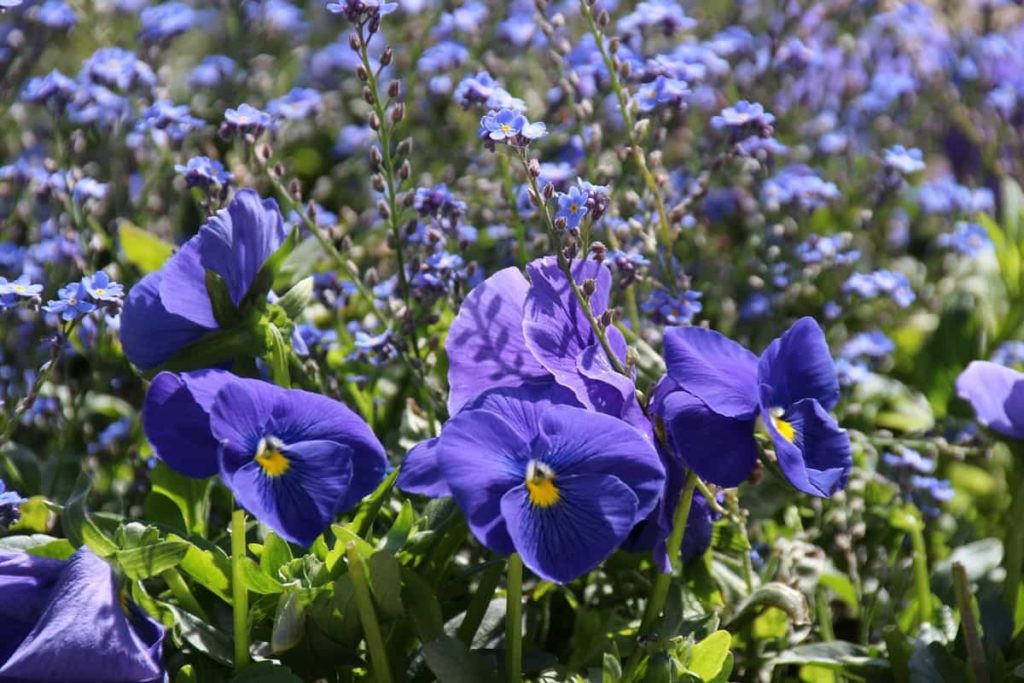
Within each flower, a pair of stamens unite in a shape that resembles a wishbone. After the frost threat has passed, plant the wishbone flowers plants in the spring. They grow quickly and bloom vigorously from early summer until the next cold season. Moreover, the plants are attractive to hummingbirds and require no deadheading.
Trailing lobelia
Trailing lobelia blooms for months with proper care and is covered by many small flowers. This popular variety is best suited to grow as the balcony flower. Trailing lobelia forms many small flowers which bloom from May to September. The flowers consist of two perfectly symmetrical halves. They are usually found in a shade of blue, but they are also available in purple and with or without a white middle eye. Lobelia generally blooms in white, blue, and lavender, all with textured foliage. They do not need deadheading, and it is a fairly low-maintenance plant.
Impatiens
Impatiens are the best choice for full-shade areas and are very easy to source in garden centers. Impatiens walleriana is easy to grow, does not require deadheading, and produces flowers for shade reliably all summer. These plants can grow even under a bench under a tree. Water regularly, but do not get them too wet. They will lose their leaves if they wilt too much due to both under-watering and over-watering. Impatiens bloom in many colors and varieties, making them an ideal option for the garden aesthetic look.
In case you missed it: How to Plant and Care for Hydrangeas: Steps to Grow Hydrangeas for Beginners
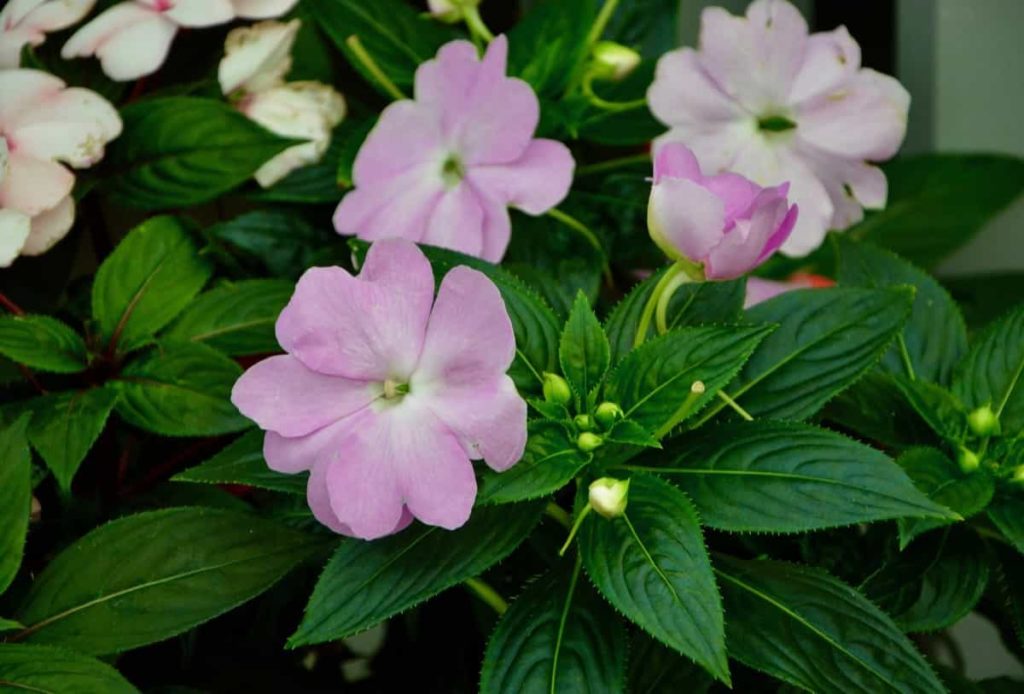
Fuchsia
fuchsias will bring elegance to your garden. These shade plants produce beautiful flowers, making them ideal for hanging baskets. The petal-filled blooms look in several shades of red, pink, and purple, and some varieties can even have variegated foliage. These beautiful shade flowers will also help to attract hummingbirds to the garden.
Balsam
Balsam blooms in various shades, an old-fashioned plant closely related to impatiens. Balsam shade flowers will grow taller and have more tangled flowers than impatiens. These plants are also self-seeds, so plant them once, and you will likely enjoy the beautiful blooms in the shade garden for years. It grows well in well-drained, evenly moist soil and will grow to a maximum height of 3 feet.
Blue cardinal Lobelia
Add lobelias to shade gardens to bring rich, true blues. These trailing, colorful annual blooms prolifically in spring and fall, and these plants almost cover themselves in flowers. Annual lobelia is a cool weather plant that can withstand the lightest conditions, including shade. These plants grow well in full shade to full sun in well-drained, moist soil and can grow up to 3 feet tall.
Oxalis
Golden-leaf varieties of oxalis are a stunning complement to browallia as the blue and gold together always look good. Oxalis varieties also have green and purple leaves and are occasionally called shamrocks because of their leaf shape. They also bloom pretty pink, white, or yellow colored flowers. Some types of these colorful shade annuals are happy in the sun; however, they need protection from the sunlight during the afternoon. These plants are well grown in full shade to full sun in dry, well-drained soil and grow up to 12 inches tall.
Browallia
Browallia, also known as bush violet, is one of the shade annuals. It has beautiful purple, white or blue flowers that form a small bush-like mound between 12 to 24 inches, depending on the variety. The endless Illumination variety does not require deadheading or a lot of fertilizer to be covered in blooms from spring to fall.
In case you missed it: How to Plant and Care for Begonias: A Step-By-Step Growing Guide for Beginners
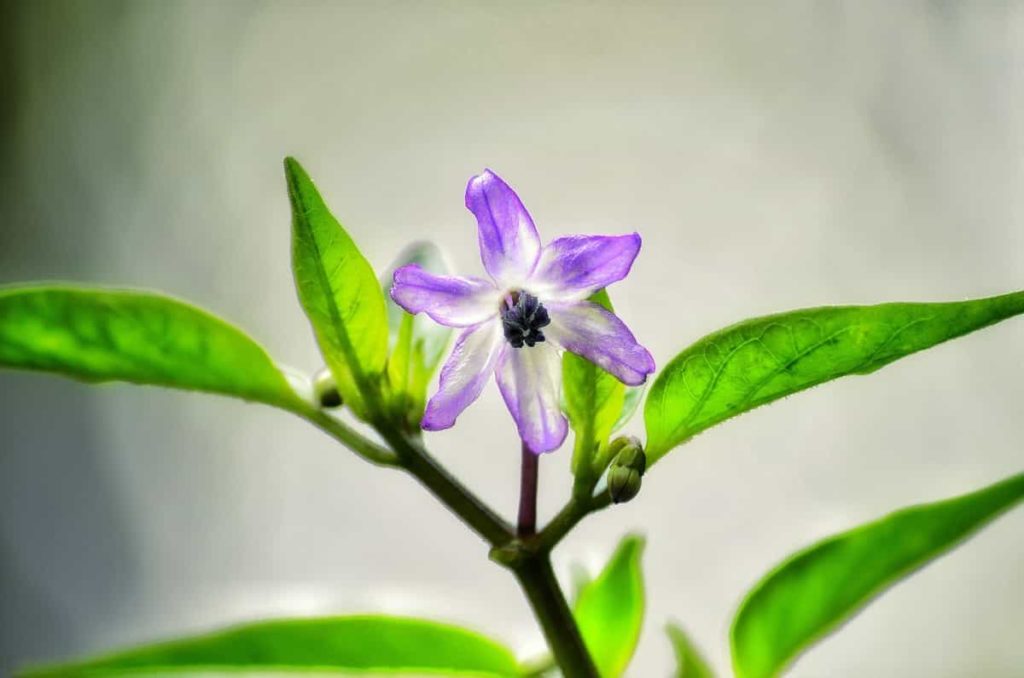
It is a low-maintenance option for the shade garden. This browallia has star-shaped flowers in blue, lavender, and white over emerald-green foliage. It is a fast grower that does well in the shade or sun. In warm-climate areas, it will self-seed, but not to the point of being considered a pest.
Begonia
These are the most excellent plants for shaded gardens, and an amazingly wide variety of beautiful begonias is available. Tuberous and wax begonias are among those which are most commonly found. However, hybrids like the big series, such as big pink with green leaf varieties, are the easiest to grow. These annual flowering are ideal for the garden because they thrive in sun, partial shade, or full shade and can withstand drought.
Caladium
Caladiums have fantastic leaves, making them valuable shade garden plants because you do not have to worry about whether they will keep flowering. These plants will give you color from when you plant them to frost. Caladium leaves mainly come in shades of pink, red, white, and green, with many multi-colors available.
Curcuma
Curcuma, also known as tulip ginger, is an exotic beauty that is easier to grow than it looks. These are one of the perfect choices for shade, partial shade, and even full sun if it stays evenly moist. These plants bloom fantastic tulip-shaped flowers all summer. Most varieties will bloom in shades of pink, purple, and white.
Coleus
This variety is a tender perennial but is usually grown as an annual for its fantastic foliage. Hundreds of varieties feature spotted leaves and are streaked with shades of chartreuse, purple, pink, red, and green. Make eye-catching combinations by growing varieties of coleus together.
Varieties of this leafy wonder can be grown in sun, partial shade, or full shade, making them ideal for adding a big, bold color to shade gardens. The color of coleus comes from its bright leaves, which appear in just about every rainbow shade. Coleus grows well in container gardens like beds and borders and can grow up to 3 feet tall.
Heliconia
It is an easy-to-grow tropical flower. This plant thrives well in the shade, partial shade, and even sunny spots only if it stays moist enough. These plants grow more vertically than many other shade plants, so heliconia is useful for adding an upright touch to planters and gardens.
In case you missed it: How to Grow Snake Plants: A Guide to Planting and Care
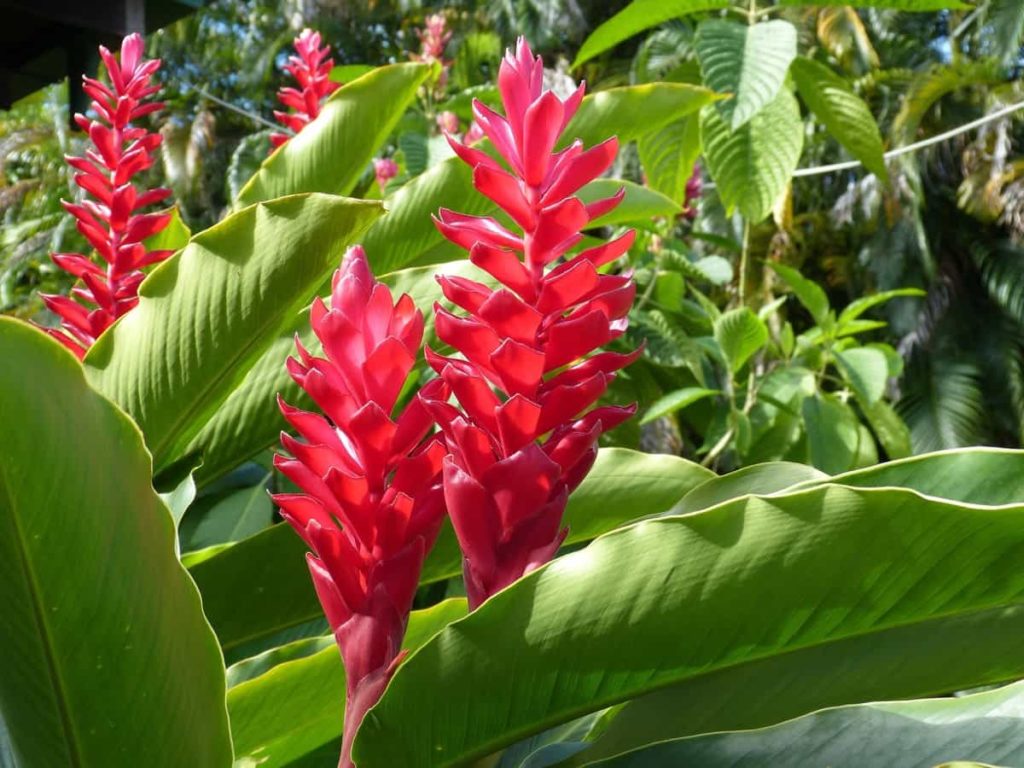
New Guinea impatiens
One of the unique shade plants, New Guinea impatiens, shows off a dazzling array of colors and bi-colors, from crisp whites and soft pinks to lavenders and purples, reds, and oranges. Some varieties offer fun variegated foliage. Like traditional impatiens, new guineas need much water and quickly wilt when they get too dry. These are resistant to disease, so plant these plants in garden beds and borders without worry. The plants do not grow as large, but their flowers are much larger.
Sweet potato vine
Sweet potato vine can produce bronze, purple, or chartreuse foliage, depending on the variety, and quickly grows once temperatures heat up. You can not beat these annual shade plants for bold summer color. Use these plants as containers plants or as a dramatic ground cover. These plants are available in many varieties, but compact, mounding types add color to containers without taking over. There is the traditional chartreuse and purple, as well as a variety of shades of red and bronze. Some types have heart-shaped leaves, and others are more hand-shaped.
Beefsteak plant
Bring a lot of color to a small area with the beefsteak plant’s bold foliage. These plants are available in shades of purple, pink, lime, and cream, and the leaves look as great as coleus. These are easy to grow. And also grow well in containers as house plants for a bold shot of winter color. These plants prefer to grow in full shade to full sun in consistently moist, well-drained soil and can reach up to 3 feet.
Viola
Violas are winter season annuals that can take full sun in early spring and fall, like lobelia. These plants will bloom later into the summer if grown in the shade. Violas produce flowers in many shades, including many beautiful bicolor flowers. Viola varieties are short-lived perennials in some areas, though they are often grown as annuals.
Polka-dot plant
Polka-dot plant grows outdoors in shaded and partially shaded spots and as a houseplant. These plants have red, pink, or white foliage accentuating dark green splashes. This low-growing annual ground cover will brighten even the dimmest corner of the garden. The polka-dot plant is relatively low-growing.
Because of this reason, it is often used in container gardens and in combination with other shade plants like New Guinea impatiens. These annuals have pretty, purple-green leaves decoratively speckled in shades of pink and white. These tropical, colorful shade plants grow well in hot and humid conditions and are relatively drought-tolerant.
Ageratum
Ageratum is one of the most highly adaptable annual blooming plants. Even though it will generally grow in full sun, it can also be grown as an annual shade plant. These flowers are commonly referred to as floss flowers, as these full-shade annuals produce fuzzy flower clusters in shades of white, red, pink, and blue.
In case you missed it: How to Start Brinjal Farming/Eggplant in West Bengal: Planting to Harvesting Guide for Beginners
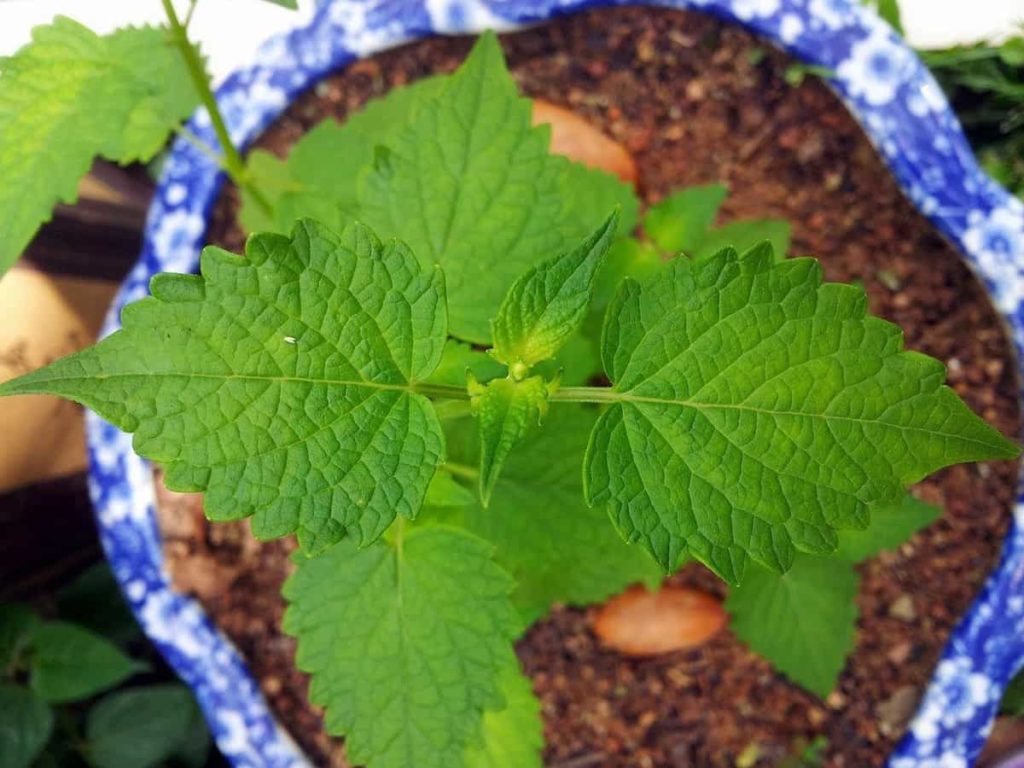
These plants are commonly used as bedding plants. Ageratum is one of the very few annuals with a true blue flower. The fuzzy flowers are dainty and feathery, sometimes delightfully fragrant. These plants are usually completely covered with flowers. Each flower cluster has 5 to 15 tubular florets.
Bromeliad
Guzmania bromeliads are another popular houseplant; they love to spend summer in a shady spot outdoors. These plants are sometimes called the scarlet star as they are an exciting way to pierce various traditional plantings with an unexpected form and punch of color.
The colorful leaves range from deepest purple to fiery shades of red, yellow, and dark orange and last for several months. These plants will prefer to grow well in good quality, well-drained potting soil that is allowed to dry out slightly between watering. They are grown with regular drip irrigation or hand watering in containers.
Purpleheart
These plants will add some rich purple foliage to the garden in summer. Popular as a groundcover in warmer climates, this tender plant looks stunning, weaving and trailing through seasonal baskets and containers. It also combs equally well with succulents and cottage garden favorites. Although the foliage color looks beautiful when grown in bright sunlight and moderately dry soil, the plant grows well in partial shade and typical container conditions. These plants can be grown up to 24 inches in height and up to 4 feet wide.
Shamrock
These plants have beautiful different colored foliage and each foliage clusters in the size of a palm. These plants are most commonly used as a groundcover or color punch in garden planters. These delightful plants will be a delight, while the dark foliage is the perfect foil for the delicate blush-pink flowers.
One of the key success factors is careful watering, especially in pots or containers. It prefers consistently moist yet not saturated conditions, so keep the irrigation lines away from the crown to avoid root and stem rot. These plants can be reached to a height of 16 inches and 12 inches wide.
Woodland tobacco
Woodland tobacco is a fragrant and surprisingly drought tolerant show-stopping annual that commonly self-sows. It has 4-5 feet-long stems supporting tubular white flower clusters that hummingbirds favor. Bright, dappled shade under trees or at least some protection from the hot afternoon sun offers the ideal conditions. Also, these annuals can be grown in full sun; however, intense heat can cause the large leaves to wilt. On average, moisture-retentive soil rarely needs supplemental water once roots have established well.
Anthurium
Anthurium plants are also called flamingo flowers for their distinctive tropical shape and dark red, green, and white colors. They can bloom for long periods constantly, making them delightful indoor plants. The blooming varieties are distinctive for their colorful, heart-shaped waxy spathes and yellow tail-like flower spikes. Other varieties have large-leaved, deeply veined foliage. Many anthuriums are climbers; all need high humidity and warmth to thrive.
In case you missed it: Indiana Vegetable Planting Calendar/Guide (IN): Month Wise, Fall, Winter, Spring, Summer, Zone 5, and Zone 6
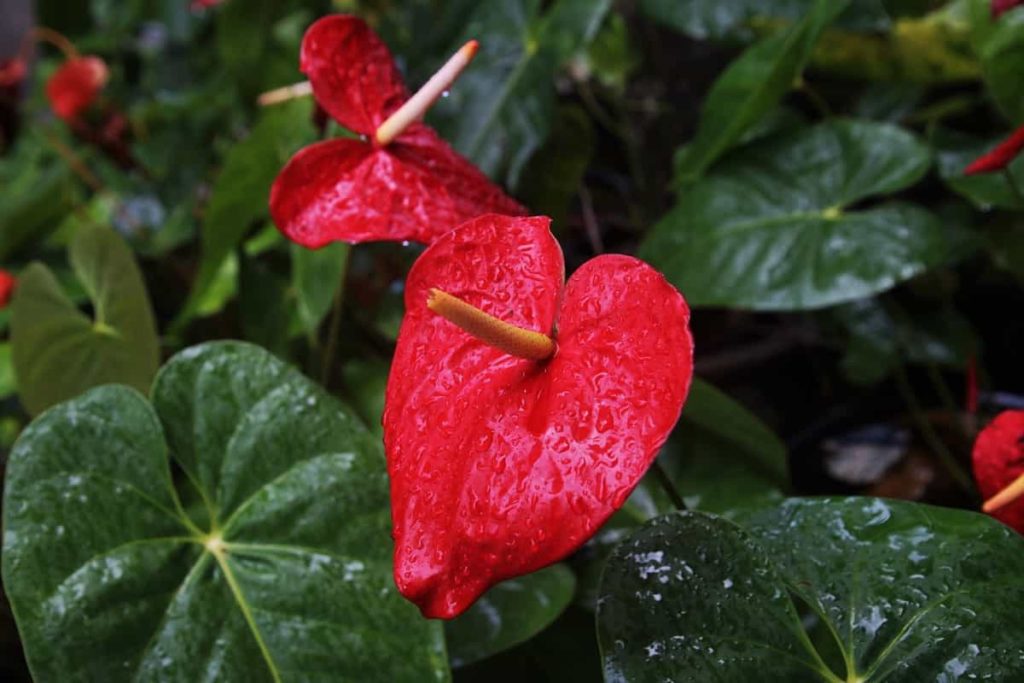
How to grow annual shade plants
Organically rich and well-drained soil is the secret to growing plants effectively in the shade or partial shade. These plants thrive well with a layer of litter enclosing the forest floor. The soil can be surprisingly thin, but that’s fine as long as the leaf litter is present. All these conditions can be recreated at home by blending shredded leaves with packaged products containing a fair amount of leaf mold or slightly composted leaves into the soil.
Soil conditions can change widely in shade pots. You can create the soil conditions required to support the growth of numerous shade plants by adding several inches of finely shredded leaves around the base of a tree in time. Generally, it requires about one to two years to get the ideal soil. Most shaded plants can be made either from plant scutting or propagating from existing flowers. It is an easy procedure that reduces the hard work and chances of failure.
- Cut or pluck existing flower buds that are well established and ready for deadheading on the plants. This plucking of flowers also helps fix the previous plant by shifting its focus from growing buds to growing roots.
- Dry these buds in a warm and airy place until they burst, collect the seeds from the flower buds, and store them until the suitable sowing time arrives.
- Sow the harvested seeds on the bed prepared with organically rich soil.
- Water generously and regularly without washing off the seeds through drain holes from the soil
- Cover the soil bed with a plastic sheet to create the required warmth for germinating the seeds and maintain the soil’s moisture.
- Observe closely for seedlings from seeds. Once the seedlings are developed with three sets of true leaves, transplant them to new pots.
- Another method to make a new plant is developing the roots from the stem. To do this, trim a stem from the well-established plant at least 2 to 6 inches long.
- From the stem, remove any extra leaves so that it does not deviate from the purpose. Take the steam and dig it in a pot’s soil or water.
- Keep the trimmed stem in a pot with soil and water it regularly. Cover the pot with a clear plastic covering to increase the humid atmosphere to create a moist environment.
- New roots will develop and emerge from the plant in about one to three weeks.
- Once you have confirmed that the stem has developed sufficient roots to grow it as a separate plant, gently pull it out from the soil and repot it.
Care for shade-loving plants
A shady growing space is distinctive because it receives less sun, has higher humidity, and retains more moisture. It also has cooler daytime, and fewer nighttime temperatures will swing than its sunny areas. Plants in shade gardens will have lower metabolic activity compared with those growing in bright sunlight. The temperature and moisture in a shade garden depend on how shady it is. Areas with no sun are the coolest and wettest, and places with four or fewer hours of shady areas exposed to sunlight daily will be warmer and drier.
This environmental difference played out in spring; the temperature will be lower in shade gardens than in sun gardens. Perennials in full sun flower beds will start growing and blooming while hostas are just poking their noses out in a shaded garden. Stay with some patience in spring and allow the shade garden areas to emerge and develop in their own time. Watering needs more attention in shade gardens to avoid root rot and root competition from surrounding trees.
Shade garden plants can live for long periods without supplemental water, so always check moisture levels before watering and only water when dry. Shade plants like Begonias and Impatiens are affected by mildew and stem rot when the soil is too wet, and the resulting areas have humidity. Feed shade plants biweekly with all-purpose fertilizer because plant metabolic demands are lower. Do not over-fertilize them, as the over-fertilization will leads to plant death.
Mulch shade gardens to control moisture levels in the soil and control weeds growth. Mulching usually occurs during the sowing of the seeds or after the seedling appears. In a simpler scenario, a 2-3 inch thick layer of mulch is enough to protect plants in a shady spot. However, a 4-6 inch thick layer of mulch completely prevents weeds’ growth.
- Management Pests and Diseases in Your Cotton Field
- Sheep Farming Business Plan for Beginners
- Aquaponic Farming at Home: A Step-By-Step Guide
- Profitable Village Farming Business Ideas in 2024
- High-Yield Aquaculture: Fast-Growing Fish for Farming
- Effective Fish Pond Construction Techniques for Beginners
- Irrigation and Water Management in Pineapple Farming
- Blossom to Harvest: Mastering Flowering and Pollination in Papaya Farming
- Pig Fattening Essentials: From Selection to Sale for Beginners
- Raising Wagyu Cattle: A Complete Guide for Premium Beef Production
- Soil Types and Their Water Holding Capacity
- Optimizing Irrigation Schedules for Coconut Groves for Enhanced Yield
- Espresso Your Garden: Coffee Grounds for Healthier Acid-Loving Plants
- The Best Soil Mix for Snake Plants: How to Mix Your Own Snake Plant Soil
- Green Thumb Success: Expert Tips for Cultivating Greenhouse Beans All Year Round
- Bloom All Year Round: The Ultimate Guide to Indoor Hyacinth Care
- Eco-Friendly Gardening: How to Make Liquid Fertilizer from Kitchen Waste
- Ultimate Guide to Grow Anise in Pots: Explore Seed Propagation to Harvesting
- Guide to Raising Chester White Pigs: Discover Breed Facts to Growth Management
- Mastering the Elegance: The Ultimate Guide to Weeping Cherry Tree Care, Planting, and Maintenance
- Ultimate Guide to Planting Garlic in Grow Bags: Growing Strategies for Beginners
- How to Fix Spider Plant Leaf-Related Problems: Natural and Organic Remedies
- 10 Reasons Why Your Tulsi Plant is Shedding Leaves: Home Remedies and Solutions
- Optimizing Growth and Yield: The Advantages of Palm Bunch Ash Fertilizer
- Utilizing Neem Oil Extract as a Natural Pesticide for Hydrangea
- From Soil to Harvest: Various Ways in Which Farmers Can Use AI Tools
- Steps to Encourage and Induce Citrus Flowers: A Comprehensive Guide
- How to Fix Snake Plant Leaf-Related Issues: Natural and Organic Remedies
- Transform Your Garden into a Fragrant Oasis with Raat Ki Rani (Night Blooming Jasmine)
- Discover the Ideal Chicken Breeds for Philippine Farms
- How to Create a Poultry Egg Farm Business Plan for Profits
- Grow Lemon Cucumbers Like a Pro: Insider Techniques for Bountiful Yields
- Ultimate Guide to Caring for Your Pink Princess Philodendron: Tips for Thriving Variegation
- Areca Nut Profit Per Acre: Calculating Yield and Cost of Cultivation
- How Kaveri Chicken is Becoming a More Profitable Breed in Indian Backyards
- Transform Your Barn: 9 Steps to Convert a Horse Stall into a Chicken Coop
